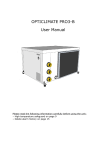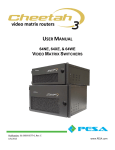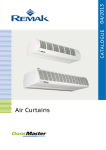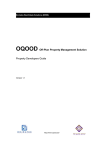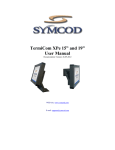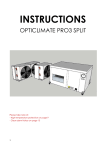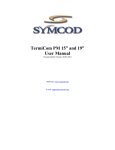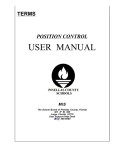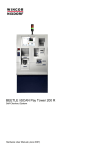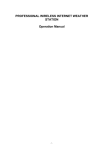Download OptiClimate System Instructions
Transcript
Installation Mounting To guarantee proper air suction, you should keep a distance of minimum 15 cm between the wall and the unit’s back side (where the carbon & dust filter and the air inlet are located). However, we recommend keeping a distance of 30 cm, because this makes it easier to access the compartment. The distance between the ceiling and the unit’s top side should be minimum 10 cm. The preference here is for larger distances, too. The unit should also be free from the wall to avoid contact noises. The unit should be mounted in such a way that the side of the condensation drain is at least 1 cm lower than the other side (fall) to ensure that the condensation flows properly. In practise, the 1 cm elevations at all corners – except the corner of the electrical compartment – are exactly right for a correct fall. Using a spirit level is recommended. 1 If the unit is going to be put on a solid base, we recommend placing the unit on rubber shock absorbers to avoid contact noises. If the unit is going to be hung, we recommend placing a wooden girder under the shock absorbers. In turn, this girder can be affixed to the ceiling using studs. Special insulating springs can be supplied for areas that have to be extra quiet. Placing the insulating springs 15 cm away from the side at the air suction and blow-out side will ensure that the unit has automatic fall and will result in a better weight distribution. Electrical connections First, the panel at the left side near the carbon & air inlet should be removed to make the various electrical connections. A water valve, a water leakage sensor, an automatic moisture meter and a room temperature sensor are supplied with the unit. Their cables can be led through an opening in the cover of the electrical compartment. The connections do not need to be released from the terminal strip. 2 Electrical water valve The plug of the water valve should be connected using the black cable supplied with the unit (see the illustration below). Water valve connection After connecting the black cable to the plug for the magnetic valve, the other side of the cable should be led through the feed-through rubber at the side of the unit. Subsequently, the two connections should be connected to the appropriate terminals (terminal N and terminal 7) on the terminal strip. Water leakage sensor The electrical compartment contains a loose, 5m long white wire: the water leakage sensor. This sensor should be led to the outside through the opening and should be placed on the ground at the lowest point. The end of the sensor cable can be split into several cores using a connector, so that more than one point is secured against leakage. If the sensor has a black cap, this should be cut off and the cores should be stripped 5 mm. The other side should be connected to the little white plug on the printed circuitboard (see the illustration below). In case of water leakage, the water supply will be stopped immediately by means of the electrical valve in the water pipe. 3 Pay attention to the colour coding on the printed circuit-board and the remote control. Alarm port The printed circuit-board has an alarm port, which is activated (makes contact) by a malfunction (error). This contact can be connected to a SMS (GSM) detector or an alarm system and it can be set to NO (contact open) or NC (contact closed) by means of the Settings menu. This means that the contact is open or closed in case of detection (see the manual of the GSM detector or alarm). Automatic moisture meter A cable is connected to the automatic moisture meter supplied with the unit. This cable should be led through the opening and connected to terminals 12 and 14 on the terminal strip. (Note: from the J-series and up, which include a light sensor, connect to terminals 12, 14 and 18.) The automatic moisture meter should be hung in the room and may NOT be covered. Temperature sensor The compartment also has a temperature sensor, which is connected to the printed circuit-board. This sensor should be led to the outside through the opening and should be hung at the level of the upper side of the vegetation. The sensor should be protected against heat radiation but may not be put in the shade. A protective cover over the sensor is sufficient. The remote control The remote control contained in the compartment can be hung in the room but can also be hung elsewhere. This way the unit can also be controlled from outside the room. 4 The remote control Feeder cables Four different models are available. For your safety and the unit’s safety, the following fuse automats and cable thicknesses for connecting the power supply are prescribed. You should comply with this. 3500pro2 6000pro2 10000pro2 15000pro2 1-phase 1-phase 3-phase 1-phase 3-phase 3-phase connection is 3 x 2.5m2 + D16F automat connection is 3 x 4mm2 + D20-1f automat or is 5 x 2.5mm2 + C16-3f automat connection is 3 x 4mm2 + D25-1f automat or is 5 x 2.5mm2 + D16-3f automat is 5 x 4mm2 + D20-3f automat The cable for the supply voltage should be led through the feed-through rubber and connected to the left-hand side of the terminal strip as described in the connection diagram. Temperature safeguard Using this safeguard, heating sources can be switched off if the temperature in the room becomes too high by a breakdown or an external cause. The wire of the control current between the clock and the relay of the switch board is interrupted and connected to terminals 15 and 16 on the terminal strip (see the connection diagram). 5 Connections to the terminal strip at the lefthand side below Connections to the terminal strip at the right-hand side below 400V 3-phase Temperature safeguard Magnetic valve Automatic moisture meter Connection diagram for Model 15000pro2 400V (only 3-phase) Connections to the terminal strip at the lefthand side below Connections to the terminal strip at the right-hand side below 230V 3-phase Automatic moisture meter 230v 1-phase: 2 loops Temperature safeguard Magnetic valve Connection diagram for Models 3500, 6000, 10000pro2 230V (1-phase and 3-phase) Supply and drain connections of the cooling water The unit has an inlet and outlet for water. The inlet should be installed at a draw-off point and should have a magnetic valve as close as possible to the draw-off point, because this is the water seal (always check the flow direction arrow on the valve!). If there is water leakage, the magnetic valve will close automatically. Make sure that the black magnetic coil of the water valve is directed upwards (preferred) or to the side. If it is directed downwards, condensation water of the valve might enter the coil. Make sure that the magnetic valve is installed at a fixed point, which is always accessible to the user. 6 Magnetic valve in the supply pipe of the water A filter should be placed in the water inlet of the 3500pro and the 6000pro. This filter prevents blockage in the unit. After installing the filter, the LDPE coupling can be installed: now the filter is affixed to its position. The water outlet can be connected directly to the drain (sewer). Alternatively, the warm water can be used for heating purposes. Installing the filter Attention: Only use solid copper or LDPE pipes and affix these properly to the wall using clamps. Always avoid putting the LDPE under tension. Make sure that the magnetic valve is affixed properly to the wall or another fixed point. Never use a garden hose! When all the LDPE connections are checked for leaks and the unit operates properly, all flare fittings should be glued. You do this by unscrewing the blue flare nut, applying some glue to the thread and tightening the blue flare nut on the glued thread. If done properly, the flare fittings will never come loose as a result of vibration. If it is necessary to loosen the flare fittings, then two water pump pliers will do the trick. Copper pipes of 15 mm or LDPE pipes of 16 mm are sufficient for all units. To prevent condensation on the water supply pipe, insulating sleeves can be used to insulate it. 7 If several units have to cool at more than 15 kW, the main pipe should be 20 mm copper or 20 or 25 mm LDPE. If the supply pipe has high pressure, a copper pipe of 15 mm will cool up to 30 kW. All types of cooling water (tap, well, pond or swimming pool water) can be used for cooling. However, tap water is preferred because you won't need to rely on additional electric pumps. Well water contains clay and iron particles that accumulate on the inner wall of the condenser. The result is that sooner or later the unit will cool less effectively or not at all. If you use well water, you can install a filter, but such a solution requires maintenance. A normal 22 mm tap water connection has sufficient capacity to cool continuously three or four 15000pro2 units at 45-60 kW. We also have suitable solutions for larger installations when there are problems with the water supply and discharge. In such cases, please contact the technical service department. Discharge of the condensation water The unit will also dehumidify the air during cooling. The moisture extracted from the air comes into the condensation drain. The condensation drain is connected to a sturdy garden hose or a pipeline that does not bend easily. The condensation water drips from the hose, which can be connected to the drain pipe. Connection of the condensation water The drain pipe of the condensation water may not have loops and may not be put under the water level in a drum. 8 If the unit is installed at the same level or lower than the drain or sewer, a condensation lift pump can collect the water. This small lift pump pumps the water through a hose of 912 mm to a height of 4 metres into the drain. Stronger pumps are also available. Drain pump of the condensation water The drain to the pump must not be under the water level and must not have loops. 9 OPTICLIMATE SPECIFICATIONS Type Voltage Phase Consumed power Cooling power Number of lamps 600W 400W Water consumption* Heating Dimensions Weight *Water consumption only during cooling. Consumption depends on the tap water temperature and is based on the Dutch climate. When the unit is installed, you can begin setting and adjusting the unit. Use the user manual for this. 10 User Manual Putting into operation Setting the cooling capacity (Valid only for the series up to the J-series; the cooling capacity is already set by default for the K-series and later.) When the unit is used for the first time, the cooling capacity has to be set. The remote control is switched to the cooling mode and the temperature is set to 16⁰C. If the room temperature is higher than 16⁰C, the magnetic valve will open (as indicated in the display of the remote control by the faucet and compressor symbols) and the unit will start cooling. Display of the remote control Now it is important to keep an eye on the manometer. The manometer is not allowed to rise too quickly. If it does, most likely water is not flowing through the unit. In that case, turn off the unit immediately and look for the cause of the problem: main faucet closed, magnetic valve connected incorrectly, etc. If the manometer rises slowly, then water is flowing through the unit and you can begin setting/adjusting the various settings. The pointer of the manometer has to point to approx. 1.6MPa 11 The intention here is that the pointer of the manometer will point to a point slightly before the left-hand side of the horizontal axis at approx. 1.6MPa (red scale division). To do this, you should turn the set screw of the capacity control. This set screw is located at the front side of the unit under the Cooling Capacity Control sticker. When putting the unit into operation, turn the set screw to the left until the pressure on the manometer indicates 1.6MPa (10-15 turns). By turning the set screw to the left, the pressure will increase and the cooling capacity will decrease. By turning the set screw to the right, the pressure will decrease and the cooling capacity will rise. It is recommended to do this if there are sources of heat in the room, so that the unit will not turn off constantly because the temperature in the room drops below 16⁰C. Capacity control 1.6MPa is an average setting. Your specific application might require higher or lower cooling capacity. The maximum cooling capacity is at 1.3MPa and the minimum cooling capacity is at 2.0MPa. The unit will consume more water at a higher cooling capacity than at a lower cooling capacity. 12 Operation 1) ON/OFF key 【On/Off】 The unit is switched ON or OFF using the On/Off key. The LED will be green when the unit is On. The LED will be red when the unit is Off. In case of malfunctioning, the LED will flash red and green. 2) Mode key 【M】 Pressing the mode key will switch the mode from day mode (cooling) to night mode (heating/dehumidifying) and v.v. The display will show a snowflake in day mode and a sun with drops of water in night mode. Night mode Temperatures for the day and night can be set using the mode function. These can still be changed later. 3) Fan speed key 【Fn】 This key is used for selecting the air speed of the fan. The sequence is as follows: automatic , low , medium , and high . The speed changes when pressing the 【Fn】 key. If you select the automatic fan mode, the unit will ventilate more of less depending on the need for cooling. 4) Temperature setting 【SET TEMP】 The temperature can be set from 16⁰C to 34⁰C. Pressing the ▲ or ▼ key will show the set temperature 【SET TEMP】 on the display. By pressing it once more, you can set the required temperature. The set temperature will be saved and stored after 3 seconds. Switching between day and night temperatures is done using the mode 【M】 key. 4B) Automatic Light Cell mode The automatic moisture meter in the J-series and up has a light cell. This light cell registers if the light burns. The result is that the timer does not have to be set. Only the day and night temperatures have to be set using the mode 【M】 key. The rest is done automatically. If you want to set the unit manually, the light cell can be switched off and the unit will operate manually. By pressing the 【M】 key for 3 seconds, the mode switches from Light Cell to Manual. By pressing the 【M】 key again for 3 seconds, the mode switches from Manual to Light Cell. If the light cell is activated, the display shows an A. 13 Attention: The external automatic moisture meter should be connected to the terminal strip in the electrical compartment (terminals 12, 14 and 18). Otherwise, the unit remains in the night mode because light is not detected. 5) Time Setting key 【T】 Press the 【T】 key once to select the hours and then press the ▲ or ▼ key to change the hours. Press the 【T】 key again to select the minutes and then press the ▲ or ▼ key to change the minutes. Now press the 【R】 key to confirm the hours and minutes that you entered. 6) Timer Setting (DAY/NIGHT programme) This function enables setting the DAY/NIGHT programme. This programme restarts every day regardless of which day it is. If the timer is set, the display will show the clock ( symbol next to the time. ) Press the 【T】 key for 2 seconds. If "---", ON becomes visible, the timer setting can be changed. Pressing the ▲ or ▼ key will allow you to set the hours of the ON time. Pressing the 【T】 key again will allow you to set the minutes of the ON time. The ON time is the time that the unit will start to cool. Pressing the 【T】 key again will allow you to set the OFF time. The OFF time is the time that the unit will start to heat/dehumidify. If the timer is not set yet, the display will show "--:--" or the time that was already set. The time can be set from 12:00 AM to 11:59 PM. The timer operates based on the American time system (AM/PM): 0:00hr = 12:00 AM 1:00hr = 1:00 AM 2:00hr = 2:00 AM ---> 11:00hr = 11:00 AM 12:00hr = 12:00 PM 13:00hr = 1:00 PM 14:00hr = 2:00 PM ---> 23:00hr = 11:00 PM 0:00hr = 12:00 AM To change the timer settings, you press the 【T】 key for 2 seconds and subsequently you press the 【R】 key. The display will show "--:--". CLOSING: Press the 【T】 key three times and wait 10 seconds to close. The settings of the current time and the timer settings should run synchronous with the times of the control panel. 7) Using the automatic moisture meter for dehumidifying during the night The automatic moisture meter can be set to the required maximum air humidity during the night. If the NIGHT mode is active and the automatic moisture meter indicates that the unit should dehumidify, the Drop symbol starts to flash. Water will be consumed during dehumidifying. The automatic moisture meter 14 8) Reading function for the temperature sensors Press the 【S】 key and the sensor will show the temperatures. The number and temperature of the sensors will show in the spot of the clock. Pressing the ▲ or ▼ key will allow the users to select the reading of the various sensors. CLOSING: Press the 【S】 key and wait 60 seconds to close automatically. C:01 = Temperature cooling block C:02 = Temperature drain water C:03 = Temperature room 2 (only in case of a Dual room configuration) 9) Reading function for the error codes The unit malfunctions if the ON/OFF LED flashes red and green. E:XX will show the actual error code. If the problem is solved automatically, the error code will disappear. The error log (alarm history) in located at the bottom in the display of the remote control. If an error occurs, the error will be continuously visible at the bottom in the display, even if the error has been solved. This way a malfunction or incorrect setting that is about to come up can be noticed and resolved at an early stage. Error codes 10) Water Leakage safeguard If there is water on the ground (e.g., by an incorrectly mounted coupling or a blocked sewer) and the water makes contact with the water leakage sensor (= the flat white wire with two blank cores at the end), the unit will stop cooling and the magnetic valve wil l close immediately. The unit will only start operating normally after the leak is repaired and the fault is reset by pressing the 【On/Off】 key. 11) Alarm port The printed circuit-board has an alarm port, which makes contact when there is an alarm or error. This contact can be connected to an alarm system or a SMS (GSM) detector. 12) Compressor Active mode If the compressor operates, the display will show the Compressor symbol at the bottom right-hand side. It will disappear if the compressor is turned off. 15 The compressor only operates during the DAY period, if the set temperature is exceeded, and during the NIGHT period, if the set air humidity is exceeded. 13) Heating Elements Active mode If the heating elements are switched on, the display will show the Hot Air symbol at the bottom right-hand side. It will disappear in if the heating elements are turned off. The heating elements only operate during the NIGHT period, if the temperature reaches a value below the set value. Settings (Setup) This menu allows you to change certain settings and to set the heating, the temperature safeguard, the auto restart and the hysteresis. Pressing the 【S】 key for more than 6 seconds will open the Settings menu. The display will show a capital D followed by a number from 01 to 28. Pressing the 【S】 key, each time briefly, allows you to scroll through the settings. The first setting is D:01, the second setting is D:02, etc. Use the ▲ or ▼ key to change a setting. You press the 【On/Off】 key to confirm. Press the 【R】 key to change nothing and to exit the menu. The settings are from D:01 to D:28. Do not adjust the settings D:10 and D:12 – D:26. These are factory settings. To restore the factory settings, you keep the 【M】 key pressed until the Settings menu opens. D:01 Switching the heating elements on/off The unit has three heating elements. The heating elements of 1-phase systems are connected to 1 phase and the heating elements of 3-phase systems are divided over 3 phases. Each of these elements can be switched on and off individually in the Settings menu. If a central heating system is used for heating, for example, all of these heating elements can also be switched off at the same time. D:1 D:1 D:1 D:1 = = = = 3 2 1 0 means means means means Three elements will heat. Two elements will heat. One element will heat. All elements are off. D:02 Temperature safeguard If the room temperature exceeds the set day temperature by more than 5⁰C, terminals 15 and 16 on the terminal strip of the unit will switch the heating elements off. The temperature for switching off can be changed by 3-9⁰C using the D:02 setting. The minimum temperature for switching off is 30⁰C and the maximum one is 40⁰C. If the set temperature for cooling mode is 28⁰C and D:02 is set to 5⁰C, the safeguard will switch on at a temperature higher than 33⁰C. If subsequently the temperature drops below 28⁰C (the set temperature for cooling mode), the safeguard will switch off. The safeguard does not impact the operation of the unit; only the heating elements are switched off. However, the display will show the detection of an error: code 15. (See also the error code table.) 16 D:03 Auto Restart after power interruption If the power is interrupted when the unit is on and the power is restored, the unit will switch on by default. If you want the unit to remain off after a power interruption, you should change the D:03 setting. D:03 = 0 means Auto Restart is off. D:03 = 1 means Auto Restart is on (this is the standard setting). The display will show an error code in case of power interruption: code 14. (See also the error code table.) D:04 Cool at Night (night cooling) on/off Using this setting, the night cooling is switched on or off. D:04 = 0 means Cool at Night is off (this is the standard setting). D:04 = 1 means Cool at Night is on. If in the night mode the Cool at Night is on and the night temperature exceeds the set value, the unit will cool the room until the set value is reached. If the room will reach a temperature below the set value, the unit will begin to heat the room. This function is useful in warm climates, in a very well-insulated room or with other sources of heat sources that cannot be switched off. D:05 Pre-Heating on/off Using this setting, the pre-heating can be switched on or off. (This function only functions when the Timer mode is set.) D:05 = 0 means Pre-Heating is off (this is the standard setting). D:05 = 1 means Pre-Heating is on. If Pre-Heating is switched on, the unit will heat the room up to the set day temperature one hour before daybreak (timer is on). At the beginning of the day, the room will be at the right temperature. Besides the advantage of giving the day temperature a jumpstart, this also prevents the cold parts of the unit from becoming wet, which reduces or prevents fungus build-up. D:06 Slow Cool-Down (post-heating) on/off Using this setting, the post-heating can be switched on or off. (This function only functions when the Timer mode is set.) D:06 = 0 means Slow Cool-Down is off (this is the standard setting). D:06 = 1 means Slow Cool-Down is on. If Slow Cool-Down is switched on, the unit will slowly cool the room until one hour after the end of the day. D:07 Dual Room (cooling two rooms 12h by 12h) on/off Using this setting, you can switch on/off the cooling of two rooms alternately. D:07 = 0 means Dual Room operation is off (this is the standard setting). D:07 = 1 means Dual Room operation is on. If the Dual Room function is active, the display will show the house at the bottom righthand side. To use this function, you will have to order a three-way valve, a second temperature sensor, possibly a plenum box and/or an external water seal. 17 D:08 Alarm port N.O. (Normally Open) or N.C. (Normally Closed) Using this setting, the alarm port can be adjusted. D:08 = 0 means Normally Closed (this is the standard setting). D:08 = 1 means Normally Open. Consult the user manual for the correct settings of the SMS (GSM) detector or the alarm system that should be connected. D:09 Water Valve options You can opt for the following: − Only open the water valve if there is a request for water. − Only use the water valve if the water leakage sensor detects a leak. Setting D:09 to 0 will only open the valve during cooling. Setting D:09 to 1 will open the valve continuously and it will only close in case of a leak. D:11 Hysteresis of the temperature Using this setting, you can adjust the hysteresis (bandwidth) of the temperature control. This is the temperature difference required to switch the compressor on and off. D:11 = 2 means the hysteresis is 2 (this is the standard setting). The hysteresis can be set from 1⁰C to 4⁰C in steps of 0.5⁰C. If, for example, the day temperature is set to 28⁰C and the hysteresis to 2⁰C, the unit will start to cool at 29⁰C and will stop cooling at 27⁰C. To shorten the hysteresis effectively, the resting time of the compressor should also be decreased (D:27). D:27 Resting time of the compressor Using this setting, you can adjust the resting time between Compressor Off and Compressor On. D:27 = 15 means the Resting Time is 15 seconds (this is the standard setting). This setting may be used if the temperature in the room increases too much because of the time that the compressor is in the resting mode. 18 D:28 Water Leakage Alarm on/off Using this setting, the water leakage alarm can be switched on or off. D:28 = 1 means the Alarm is on. D:28 = 0 means the Alarm is off. 19 Inspection/Maintenance Frequently check whether all couplings of the water connections are tightened well. Also check that there are no leaks. Frequently check whether there is no thickening of the black coil (black block on the brass valve) of the brass magnetic valve (water seal). In case of bad contact (moist contact), the coil can become too hot and expand. If this is not fixed, the coil can burn out and the magnetic valve will no longer open. The dust filter at the back side of the unit should be checked every 10-12 weeks for dust accumulation. If the filter has a layer of dust, the dust should be removed using a vacuum cleaner. The carbon filter should be replaced every 10-12 weeks in order to guarantee proper operation of the unit. This is essential and should not be forgotten! If this is not carried out, the filter will break down sooner than normal. To replace the carbon filter, you first have to remove the dust filter. Fault analysis and error messages If the unit does not switch on and the remote control display and the LEDs on the printed circuit-board are off, most likely there is no power supply. It is also possible that the internal fuse has blown. This fuse is located near the printed circuit-board in a synthetic housing. If there is power supply (the LED on the printed circuit-board flashes and the remote control display shows E:01), but the unit does not switch on, two of the three phases should probably be switched. It does not matter which ones of the three phases. If the fuse automat burst when the unit starts to cool, most likely a fuse of the wrong value or incorrect type was installed. Check the technical specifications ( page 12) for the correct details. If the unit make strange noises or cools poorly, you should check the manometer (check that the pointer does not point too far to the right/centre of the screen) and check that the water temperature does not exceed 55⁰C. In that case, make sure that the unit receives more water and check whether the pointer of the manometer drops. Subsequently, set the manometer as described in the Settings section. If water continues to flow through the apparatus while the unit is off, it might be possible that the magnetic valve is mounted incorrectly. Check the arrow on the brass housing. If water drips from the sides of the unit, you have a problem with the condensation water drainage. Check whether the unit has sufficient fall (see the Mounting section) using a spirit level. It is also possible that the condensation hose has too many loops/bends or is blocked. 20 Fault code list Error 01 = Usually means that the phases are crossed (reversal). Only active in the 15000 series. Two of the three phases should probably be switched. It does not matter which ones of the three phases If the unit has operated before, the phases are connected properly. You may have a problem with the power supply (voltage). You can check this by observing which LED is burning on the little white cupboard in the top of the electrical compartment. Over voltage = Voltage is too high (this fault no longer occurs in pro2 models). Low voltage = Voltage is too low. Phase loss = Phase is interrupted. Reversal = Phase sequence is wrong (crossed). Normal = Phases are connected properly and the voltage is correct. Error 02 = Condensation water tray sensor The unit does not have sufficient fall in accordance with the user manual or the condensation water hose is blocked or does not run down well. Error 03 = Drain water temperature is higher than 57⁰C If the error message appears when the unit is already operating for a while, too little or no water flows through the unit. The pressure may be set too high. The maximum permitted pressure is 2.2MPa (see the Settings section to obtain the correct flow). Error 04 = Ambient temperature is too low The unit is placed in a cold environment, causing the risk of freezing. The room in which the unit is located should be warmer than 4⁰C. Error 08 = Water leakage safeguard is active There is a water leak. Repair the leak and dry the end of the sensor. In Dual Room systems, error 08 indicates a problem with the second temperature sensor. Error 09 = Thermal safeguard of the compressor is activated. The compressor consumes too much current. Contact the Technical Service department, if the thermal safeguard jumps again after resetting. The thermal safeguard is located at the left-hand side near the printed circuit board in the electrical compartment. Error 10 = Anti-freeze safeguard, the temperature of the cooling block is too low If the cooling block is colder than 0⁰C, it can freeze up. The unit stops cooling and starts to defrost. Most likely too much water flows through the unit. This causes the unit to have too much cooling capacity. The minimum pressure is 1.3MPa. You might have to increase the pressure slightly to reduce the cooling capacity. See the Settings section to remedy this. The dust/carbon filters may also be blocked or the blow-out is too scanty/tight (too few holes or the hose is too thin). The result is that the unit cannot get rid of its cold air. Error 11 = Poor cooling There is no proper cooling. The condenser of the compressor may be faulty or may have a loose contact. Tighten all wires. Also check the pressure on the manometer if the compressor does not function. Contact the Technical Service department if the pressure is too low. Error 12 = High pressure protection If this error message appears, most likely water does not flow through the unit. This should be resolved immediately, because the unit cannot get rid of its hot air and the pressure of the cooling system will repeatedly increase too much. It is also possible that the unit gets too little water (see the Settings section to obtain the correct flow). 21 If water does not flow through the unit and the taps and magnetic valve are open, the heat exchanger might be clogged (if you are using well water or polluted water). Check the filter in the inlet. Error 13 = Low pressure protection Check the manometer when the unit is off. Contact the Technical Service department, if the pressure is below 5 bar/0.5Mpa. Error 14 = Current interruption alarm The unit is deprived of current. This alarm is only visible in the alarm history at the bottom of the display and indicates that there was a problem with the current. Error 15 = High ambient temperature safeguard is active As soon as the ambient temperature drops lower than the set day temperature, the unit will switch on the sources of heat again and the error code will disappear. Error 16 = Water leakage safeguard is active There is a leak. The external water sensor (= the 5m long wire with two blank cores at the end) makes contact with water and the water supply is closed. Once the leak is repaired, you have to press the 【ON/OFF 】 key and the unit will operate normally. Please contact your supplier in case of any other error message. 22 Optionally available Super insulating springs (shock absorbers for extra quiet rooms) These absorbers are meticulously calculated to bear the unit’s weight and ensure nearly 100% contact insulation. No other solutions on the market offer a similar level of contact insulation. Anti-vibration plates (absorbing plates for extra quiet rooms) These plates can be glued to the flat panels of the unit to limit noises radiated by the unit to a minimum. The plates are self-adhesive. Connection set for open water (ditch, canal, etc.) consisting of a closed heatexchanging system with ethylene glycol filling (anti-freeze) and a pump. High-quality condensation water lift pump Lift height up to maximum 4 metres. This pump is often used if there is no drain for the condensation water in the vicinity or if the unit is placed lower than the drain. PVC hose connection is 9-12 mm. Three-way valve with servomotor and additional temperature sensor of 5 metres for Dual Room applications. This valve enables cooling two rooms 12h by 12h if the Dual Room function is switched on. Each room has its own sensor and it scans the room where the cooling is activated. The High Temperature Safeguard will be active for both rooms simultaneously. External water leakage safeguard If you use the Dual Room function, the water leakage safeguard of the unit is cancelled. It is recommended to use the external water sensor. Plenum box This box can be installed at the back side of the unit, so that the unit can be placed outside the room. One to three hoses can be connected to the plenum box to suck out the warm air from the room. 23























